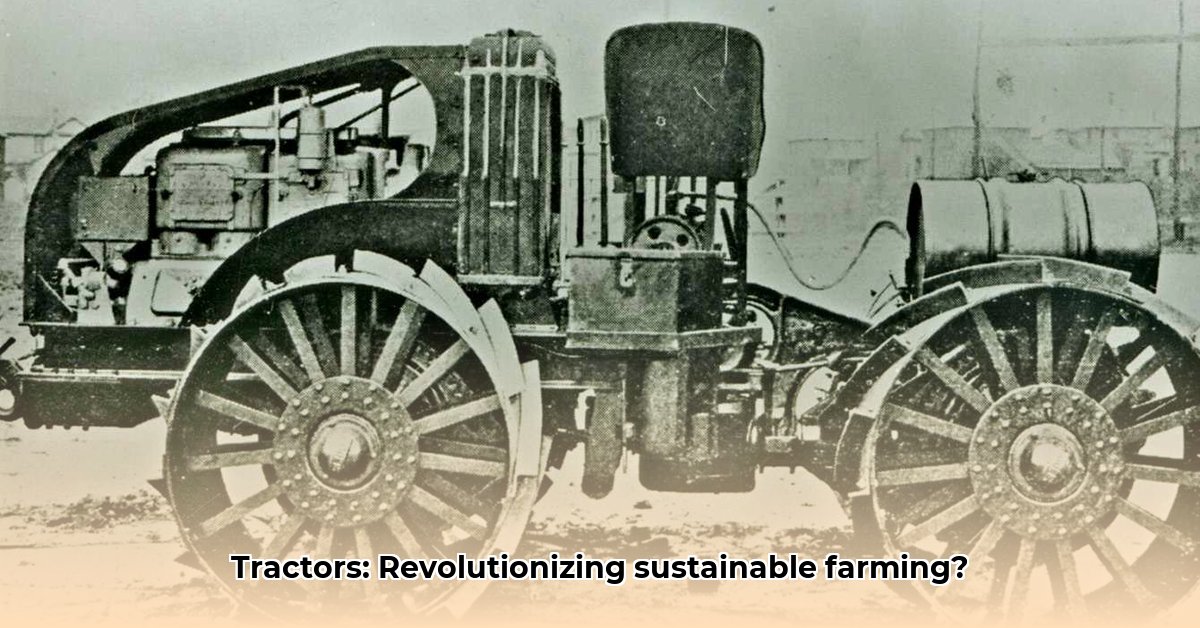
From Steam Power to Sustainable Solutions: A Technological Journey
The story of the tractor is not merely a chronicle of mechanical innovation; it's a narrative deeply intertwined with the evolution of agriculture and our planet's food security. From its humble beginnings as a cumbersome steam-powered behemoth to today's technologically advanced, sustainable models, the tractor's journey reflects humanity's relentless pursuit of efficient and responsible food production. But how did this seemingly simple machine fundamentally reshape the agricultural landscape? Let's delve into its compelling history. For more information on tractor benefits, see this helpful guide.
The Dawn of Mechanization: Steam's Early Impact
Imagine the late 18th century: agriculture was a labor-intensive endeavor, heavily reliant on animal power. This changed with the advent of steam-powered tractors – enormous, unwieldy machines that transformed plowing from a backbreaking task into a mechanized process. While impractical for most farmers due to their size, fuel consumption, and operational complexity, these early pioneers demonstrated the potential of replacing human and animal labor with machines. This marked the critical first step towards a revolution in farming. How could such a significant technological leap be further improved?
The Internal Combustion Engine: A Turning Point
The true breakthrough arrived in the early 20th century with the internal combustion engine (ICE). Tractors shrank in size, increased in agility, and became more user-friendly. This transformation was analogous to the shift from horse-drawn carriages to automobiles – a dramatic improvement in efficiency and maneuverability. Major players like Ford and International Harvester recognized the potential and aggressively entered the market, shaping the industry's future. A pivotal innovation of this period was the development of the three-point hitch (a system that allows for easy attachment of various implements), transforming tractors into versatile workhorses. This increased versatility dramatically reduced labor costs and increased crop yields. What other advancements would further enhance the capabilities of the tractor?
Mid-20th Century: Specialization and Enhanced Power
The mid-20th century witnessed remarkable advancements. Tractors became more robust, reliable, and efficient. Engineers focused on refining engine technology, hydraulic systems, and overall design. Specialization emerged, with different models designed for specific tasks and crops – from powerful machines for vast wheat fields to smaller, more precise tractors for vineyards. This period of innovation was inseparable from the post-war boom in agricultural productivity and played a vital role in global food security. However, increased efficiency had some unintended consequences. What were the downsides of this remarkable progress?
The Green Revolution: A Double-Edged Sword
The tractor was instrumental in the post-war "Green Revolution," a period of unprecedented agricultural productivity. The world could produce far more food, averting widespread famine. However, this success came at a cost. The widespread use of chemical fertilizers and pesticides – often applied with tractors – raised environmental concerns. This led to a growing awareness of the need for more sustainable agricultural practices. How could this success be reconciled with the environmental impact of these methods?
The Path to Sustainability: Electric and Autonomous Tractors
The tractor's evolution continues. Growing concerns about climate change and resource depletion have driven the development of electric and autonomous tractors. These eco-friendly machines aim to reduce our reliance on fossil fuels, lessen soil compaction, and enhance efficiency through precision farming. Imagine a future where quiet, autonomous tractors navigate fields using GPS and AI, optimizing resource use—a truly sustainable vision of agriculture. "The use of autonomous tractors is expected to significantly reduce labor costs and enhance efficiency," says Dr. Anya Sharma, Professor of Agricultural Engineering at the University of California, Berkeley. But are these technological advancements sufficiently widespread to make a substantial difference?
Assessing Tractor Environmental Impact: A Life Cycle Approach
The tractor’s impact extends beyond field work. Understanding its environmental footprint is crucial for sustainable agriculture. How can we effectively compare the environmental performance of different tractor types?
Deconstructing the Environmental Footprint
Effectively assessing the environmental impact of a tractor requires a life cycle assessment (LCA). This comprehensive approach examines every stage of a product's life, from raw material extraction to disposal. An LCA for a tractor would evaluate manufacturing, transportation, operation, and disposal, considering factors like greenhouse gas emissions, water consumption, and land use. Dr. David Miller, a researcher at the USDA’s Agricultural Research Service, explains, “Using a life cycle perspective is crucial for a complete understanding of the environmental impact linked to each tractor model”.
Key Stages of the Life Cycle Assessment
Manufacturing: This stage considers the energy consumption and emissions associated with producing the tractor, including material sourcing. A tractor built using recycled materials has a notably lower carbon footprint.
Operational Phase: Fuel consumption is the dominant factor here. Fuel-efficient tractors and precision agriculture techniques minimize emissions and improve sustainability.
End-of-Life (EOL): Recycling and responsible disposal are paramount. Tractors designed for easy disassembly and material recovery reduce environmental burden.
Data-backed rhetorical question: Does the environmental impact of choosing a smaller, more fuel-efficient tractor outweigh its potentially reduced capacity for larger-scale farming operations?
Quantifiable fact: Studies show that fuel consumption during operation accounts for over 70% of a tractor's total lifecycle greenhouse gas emissions.
Human element (Expert Quote): “The future of farming hinges on embracing sustainable practices, and this includes making informed decisions about the tractors used,” states Dr. Emily Carter, Director of Sustainable Agriculture at Cornell University.
By employing a comprehensive LCA, we can objectively compare different tractor types and identify the most environmentally responsible choices for sustainable agriculture.
Key Takeaways:
- Life Cycle Assessment (LCA) is crucial for evaluating a tractor's full environmental impact.
- Fuel efficiency during operation is a major determinant of environmental performance.
- Sustainable tractor design considers recyclability and responsible end-of-life management.
- Precision agriculture minimizes resource use and reduces environmental impact.